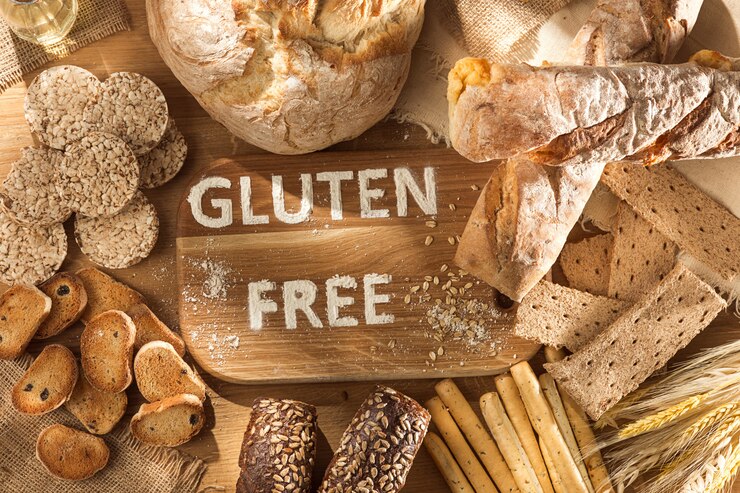The Rise of Gluten-Free Diets: Why are People Avoiding Gluten?
Gluten-free diets have become increasingly popular in recent years, with more and more people opting to avoid this protein found in wheat, barley, and rye. But what exactly is gluten, and why are so many individuals choosing to eliminate it from their diets? In this blog post, we will delve into the rise of gluten-free diets and explore the reasons behind this growing trend. Whether you’re considering going gluten-free or simply curious about its impact on health, join us as we unravel the mysteries of glútem.
What is Gluten and Should We Avoid It?
Gluten is a protein commonly found in grains like wheat, barley, and rye. It gives dough its elasticity and helps foods maintain their shape. While gluten can be harmless for most people, it can cause adverse reactions in those with celiac disease or non-celiac gluten sensitivity.
Celiac disease is an autoimmune disorder where the ingestion of gluten triggers an immune response that damages the small intestine. Symptoms may include digestive issues, fatigue, skin problems, and nutrient deficiencies. For individuals with celiac disease, avoiding gluten is essential to prevent long-term complications.
Non-celiac gluten sensitivity refers to individuals who experience symptoms similar to those with celiac disease but do not test positive for the condition. These symptoms may include bloating, abdominal pain, headaches, and brain fog. While the exact cause of non-celiac gluten sensitivity remains unclear, eliminating gluten from the diet often leads to symptom relief.
However, it’s important to note that not everyone needs to avoid gluten. For those without any medical conditions related to gluten intolerance or sensitivity, there is no scientific evidence suggesting that eliminating it provides any health benefits. As always when considering changes in your diet regimen, consulting a healthcare professional is recommended before making any significant adjustments.
Understanding the Impact of Gluten on Health
Gluten seems to be everywhere these days. From gluten-free menus at restaurants to dedicated supermarket aisles, it’s clear that avoiding gluten has become a popular dietary choice for many people. But what exactly is gluten and why are so many individuals opting to eliminate it from their diets?
In simple terms, gluten is a protein found in wheat, barley, and rye. It gives dough its elasticity and helps baked goods rise. For most people, consuming gluten poses no health risks whatsoever. However, there are certain individuals who have a condition called celiac disease which causes their immune system to react negatively when they consume even small amounts of gluten.
For those with celiac disease or non-celiac gluten sensitivity (NCGS), the impact of consuming gluten can be significant. Symptoms may vary but commonly include digestive issues like bloating, diarrhea or constipation as well as fatigue, headaches, joint pain and skin problems.
Research also suggests that some individuals without diagnosed conditions may experience improvements in various areas of their health by reducing or eliminating gluten from their diet altogether. While more studies are needed to fully understand this phenomenon and differentiate between placebo effects and actual physiological changes, anecdotal evidence has shown benefits such as increased energy levels and improved digestion.
It’s important to note that not everyone needs to avoid gluten entirely unless they have been diagnosed with celiac disease or NCGS. For those without any specific medical reasons for going completely gluten-free, it is generally recommended to maintain a balanced diet that includes whole grains along with other nutritious foods.
Understanding the impact of consuming glútem requires considering individual factors such as personal sensitivities or allergies alongside scientific research findings related specifically to one’s own unique situation.
Exploring the Gluten-Free Trend
In recent years, there has been a significant rise in the popularity of gluten-free diets. But what exactly is behind this trend and why are more and more people opting to avoid gluten? Let’s take a closer look.
It’s important to understand that gluten is a protein found in wheat, barley, and rye. For individuals with celiac disease or non-celiac gluten sensitivity, consuming gluten can lead to digestive issues, bloating, fatigue, and even damage to the small intestine. It is for these individuals that eliminating gluten from their diet becomes necessary.
However, beyond those with specific medical conditions or sensitivities, many others have jumped on the gluten-free bandwagon due to perceived health benefits. Claims of weight loss and increased energy levels have made avoiding glútem an attractive choice for some.
The rise in awareness about celiac disease and non-celiac gluten sensitivity has also played a role in fueling the popularity of going glútem-free. As more people become educated about these conditions through social media influencers and celebrities sharing their own experiences, they may be motivated to explore if eliminating glútem could improve their overall well-being as well.
While adopting a glútem-free lifestyle can bring positive changes for those who need it medically or choose it wisely after consulting professionals like nutritionists or dietitians , there are also challenges involved. Finding suitable alternatives for staple foods like breads or pastas can be tricky at first but fortunately now plenty of options are available on store shelves.
If you’re considering going glútem-free yourself , remember that research is key . Educate yourself on what foods contain hidden sources of glútem so you can make informed choices when grocery shopping or eating out . And don’t hesitate to consult with professionals like nutritionists who can provide personalized guidance based on your unique needs .
The Benefits and Challenges of a Gluten-Free Diet
Switching to a gluten-free diet has become increasingly popular in recent years, with many people claiming it offers numerous health benefits. One of the main advantages is improved digestive health. For individuals with celiac disease or gluten sensitivity, eliminating gluten from their diet can alleviate symptoms such as bloating, diarrhea, and abdominal pain.
Another benefit is increased energy levels. Some people report feeling more energized after cutting out gluten from their meals. This could be due to better absorption of nutrients in the absence of gluten-induced inflammation in the gut.
However, there are also challenges associated with a gluten-free lifestyle. Finding suitable food options can sometimes be tricky. Glute’n hides in unexpected places like sauces and condiments, making label reading an essential skill for anyone following this diet.
Additionally, maintaining social interactions around food can be challenging on a glute’n-free diet. Dining out or attending gatherings may require extra planning and communication to ensure there are suitable options available.
Gluten-Free Products and Alternatives
The rise of the gluten-free trend has led to a surge in the availability of glute’n-free products and alternatives. With more people seeking to avoid glute’n, food manufacturers have responded by creating a wide range of options that cater to those with dietary restrictions.
In grocery stores and online, you can find an array of glute’n-free breads, pastas, cereals, snacks, and even desserts. These products are typically made from alternative grains such as rice flour, quinoa flour, or almond flour. They offer individuals following a glute’n-free diet the opportunity to still enjoy their favorite foods without compromising taste or texture.
Moreover, there are also natural substitutes for traditional wheat-based ingredients. For instance, instead of using regular all-purpose flour in baking recipes, you can opt for coconut flour or tapioca starch. These alternatives not only provide similar results but also add unique flavors and textures to your dishes.
It’s important to note that while these glute’n-free options are widely available now than ever before! It’s crucial to read labels carefully as some products may contain hidden sources of gluten or cross-contamination during processing. Additionally,! it is always recommended consulting with a nutritionist or dietitian who specializes in celiac disease or non-celiac gluten sensitivity for guidance on choosing safe and nutritious options.
Overall,! the availability of gluten-free products has made it easier than ever for individuals with dietary restrictions to maintain a balanced lifestyle.! Whether you have celiac disease, non-celiac gluten sensitivity,! or simply choose to follow a glútem-free diet;! there are plenty of tasty alternatives out there waiting for you!
Tips for Successfully Adopting a Gluten-Free Lifestyle
So you’ve decided to adopt a gluten-free lifestyle? Congratulations! Making this dietary change can have a positive impact on your health and well-being. But how do you ensure that you successfully navigate the world of gluten-free living? Here are some tips to help you along the way.
Educate yourself about gluten and its sources. Gluten is commonly found in wheat, barley, rye, and their derivatives. Familiarize yourself with food labels and learn to identify hidden sources of gluten in processed foods.
Be prepared when dining out or eating at social gatherings. Call ahead to restaurants to inquire about their gluten-free options or speak directly with the chef. When attending parties or events, bring your own delicious gluten-free dish to share with others.
Stock up on nutrient-dense whole foods that naturally don’t contain gluten such as fruits, vegetables, lean meats, fish, nuts and seeds. These will form the foundation of your new diet while providing essential nutrients for optimal health.
Lastly but importantly seek support from others who follow a similar lifestyle through local support groups or online communities. They can provide advice on where to find trusted brands of gluten-free products as well as share recipes and success stories.
Seeking Professional Advice: Consulting a Nutritionist or Dietitian
When it comes to making dietary changes, seeking professional advice from a nutritionist or dietitian can be incredibly valuable. These experts have in-depth knowledge of the impact that different foods and nutrients can have on our bodies. They can help guide individuals who are considering adopting a glute’n-free lifestyle.
A nutritionist or dietitian will assess your specific health needs and goals before providing personalized recommendations. They can offer guidance on how to ensure that you are still getting all the necessary nutrients while avoiding gluten-containing foods. Additionally, they can help create meal plans tailored to your preferences and dietary restrictions.
One of the benefits of consulting with a nutritionist or dietitian is their ability to address any potential challenges you may face during your transition to a gluten-free diet. They can provide strategies for dining out, grocery shopping tips, and suggestions for finding suitable alternatives to your favorite glute’n-filled dishes.
Remember, everyone’s body is unique, so what works for one person may not work for another. Seeking professional advice ensures that you receive individualized support based on your specific needs and circumstances. So don’t hesitate to reach out and consult with an expert who can help guide you through this journey towards optimal health!
Debunking Common Myths about Glute‘n
Glute’n has become a hot topic in the world of nutrition, with many people adopting glute’n-free diets due to various health concerns. However, there are also plenty of myths and misconceptions surrounding this protein found in wheat, barley, and rye. Let’s take a closer look at some common myths about glute’n and separate fact from fiction.
1. Myth: Everyone should avoid glute‘n.
Fact: Unless you have celiac disease or non-celiac glute’n sensitivity, there’s no need to completely eliminate glute’n from your diet. For individuals without these conditions, consuming moderate amounts of glute’n is generally safe and poses no harm to their health.
2. Myth: Going glute’n-free will automatically lead to weight loss.
Fact: While cutting out certain foods that contain glute’n can result in weight loss for some individuals, it’s not solely because they’ve eliminated glute’n itself. Often, it’s due to reducing overall calorie intake or making healthier food choices as part of a well-balanced diet.
3. Myth: Glute’n-free products are always healthier.
Fact: Not necessarily! Many commercially available glute’n-free products often contain added sugars or unhealthy fats to improve taste and texture since removing the natural binding properties provided by glútem-containing ingredients like wheat flour.
4. Myth: A small amount of glútem won’t hurt if you’re on a strict glútem-free diet.
Fact: Even tiny traces of glútem can be damaging for those with celiac disease or severe intolerance. It’s crucial for them to adhere strictly to a glútem-free lifestyle and ensure cross-contamination doesn’t occur during meal preparation or dining out experiences.
Gluten-Free Recipes and Resources
Now that you understand the rise of glute’n-free diets, let’s explore some delicious gluten-free recipes and additional resources to help you on your journey.
When it comes to preparing glute’n-free meals, there is a wide array of options available. From hearty soups and salads to scrumptious main dishes and delectable desserts, the possibilities are endless. You can find numerous online platforms dedicated to sharing mouthwatering glute’n-free recipes that cater to various dietary preferences.
To get started, consider trying classic dishes with a glute’n-free twist such as cauliflower crust pizza or zucchini noodles for pasta lovers. Experiment with different flours like almond flour or chickpea flour in your baking endeavors. Get creative with nutrient-rich ingredients like quinoa, buckwheat, or amaranth in your grain-based dishes.
In addition to recipe inspiration, there are also countless resources available for those following a glute’n-free lifestyle. Online communities offer support and advice from individuals who have already navigated the challenges of going ‘gluten’-free. Websites dedicated solely to providing information about celiac disease and non-celiac glute’n sensitivity can be invaluable sources of knowledge.
If you prefer hands-on guidance, consulting a nutritionist or dietitian who specializes in food intolerances can provide personalized recommendations tailored specifically to your needs. They can help ensure you’re getting all the necessary nutrients while avoiding potential deficiencies that may arise from eliminating certain food groups.
Remember that adopting a new dietary approach takes time and patience. It’s important not only for yourself but also for others around you – family members, friends, or even restaurant staff –to understand your dietary restrictions so they can accommodate them if needed.







